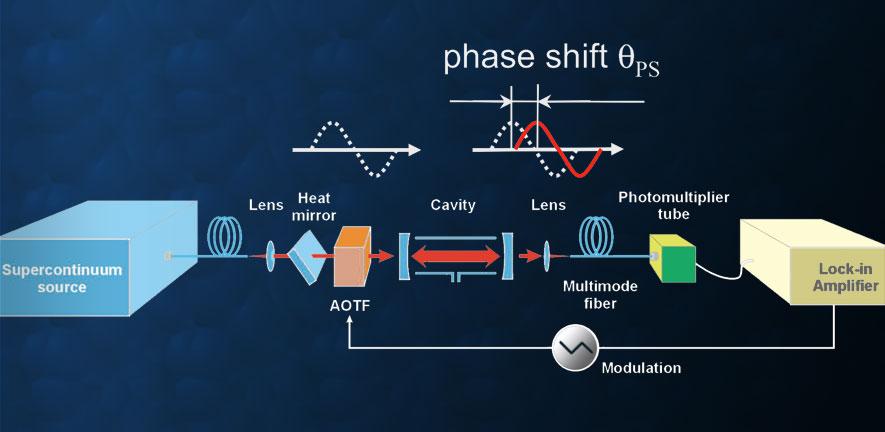
The generation of broad bandwidth supercontinuum generation is central to much of our research in molecular spectroscopy and imaging. For an overview of methods we use see [1]. Previously we performed a lot of molecular imaging in reactive gas flows, an area we are less involved in now. If you are interested in this work, please refer to this link. Current projects are:
High sensitivity spectroscopy with supercontinuum radiation
We have pioneered the use of incoherent supercontinuum radiation in ultrahigh sensitivity cavity enhanced absorption spectroscopy (CEAS). In the gas phase we have reached record sensitivities for broad bandwidth CEAS, closely approaching those of single frequency or frequency comb absorption spectroscopies, but offering speed advantages and much reduced experimental complexity. More details can be found here and in [2]. We have expanded these methods for measurements in the liquid phase [3] and for the probing of electrochemical reactions [4] and have recently developed broad band cavity ringdown spectroscopy (CRDS) with supercontinuum sources using novel single photon avalanche photo diode (SPAD) detector arrays [5]. Applications for these technique range from the biophysical study of amyloid aggregation reactions to atmospheric chemistry.
Wavelength agile sensing
Through temporal dispersion of different wavelength components in supercontinuum it is possible to perform ultra high speed wavelength sweeps, permitting spectra capturing hundreds of nanometers at 100s of kHz repetition rates. This permits the simultaneous detection of multiple gas species, e.g. H20 and CH4 e.g. for the study of fast chemical kinetics in flows. For details see here and [6,7].
Modelling Supercontinuum Radiation for spectroscopy applications
The group performs extensive theoretical work on incoherent supercontinuum generation in photonic crystal fibres to optimize its use for spectroscopy. Algorithms developed in the group to solve the non-linear Schrödinger equation have become a standard method for modelling this process, for details see [6]. We have used this to study soliton generated noise and optical rogue waves [7,8].
Stable Calibration Burner
The laser analytics group has developed a novel flat flame calibration burner that supports stable laminar flames and combines many of the advantages of several widely used burner designs without their disadvantages. It permits the application of point measurement techniques, line-of-sight techniques and planar imaging techniques with the advantage that trace species, such as metal atoms, can be easily introduced into the flame. The purpose of the burner is to provide an accurate means for calibrating and validating other laser based thermometry and absorption techniques. We have completely characterised this flame and set up a database, which can be used by other researchers for reference. We have used coherent anti-Stokes Raman scattering (CARS) to obtain accurate temperature profiles in this flame over a range of operating conditions. Although experimentally complex, CARS still serves as a "gold standard" for other laser based measurements as it combines excellent accuracy and precision with a high spatial resolution. We have pushed CARS to its limits in terms of measurement fidelity and its application in the calibration of our burner describes some of the most precise and accurate measurements ever reported with this technique [9]. Design Files
[1] Kaminski CF et al., "Supercontinuum radiation for applications in chemical sensing and microscopy" (2008)
[2] Langridge JM et al., "Cavity enhanced absorption spectroscopy of multiple trace gas species using a supercontinuum radiation source" (2008)
[3] Kiwanuka SS et al., "Sensitive Method for the Kinetic Measurement of Trace Species in Liquids Using Cavity Enhanced Absorption Spectroscopy with Broad Bandwidth Supercontinuum Radiation" (2010)
[4] Schnippering M et al., "Evanescent Wave Broadband Cavity Enhanced Absorption Spectroscopy using Supercontinuum Radiation: A New Probe of Electrochemical Processes" (2008)
[5] Kiwanuka SS et al., "Development of broadband cavity ring-down spectroscopy for biomedical diagnostics of liquid analytes" (2012)
[6] Hult J et al., "High bandwidth absorption spectroscopy with a dispersed supercontinuum source" (2007)
[7] Hult J et al., "Dispersion measurement in optical fibers using supercontinuum pulses" (2007)
[8] Liu C et al., "Predicting supercontinuum pulse collisions with simulations exhibiting temporal aliasing" (2010)
[9] Hartung G et al., "A flat flame burner for the calibration of laser thermometry techniques" (2006)

